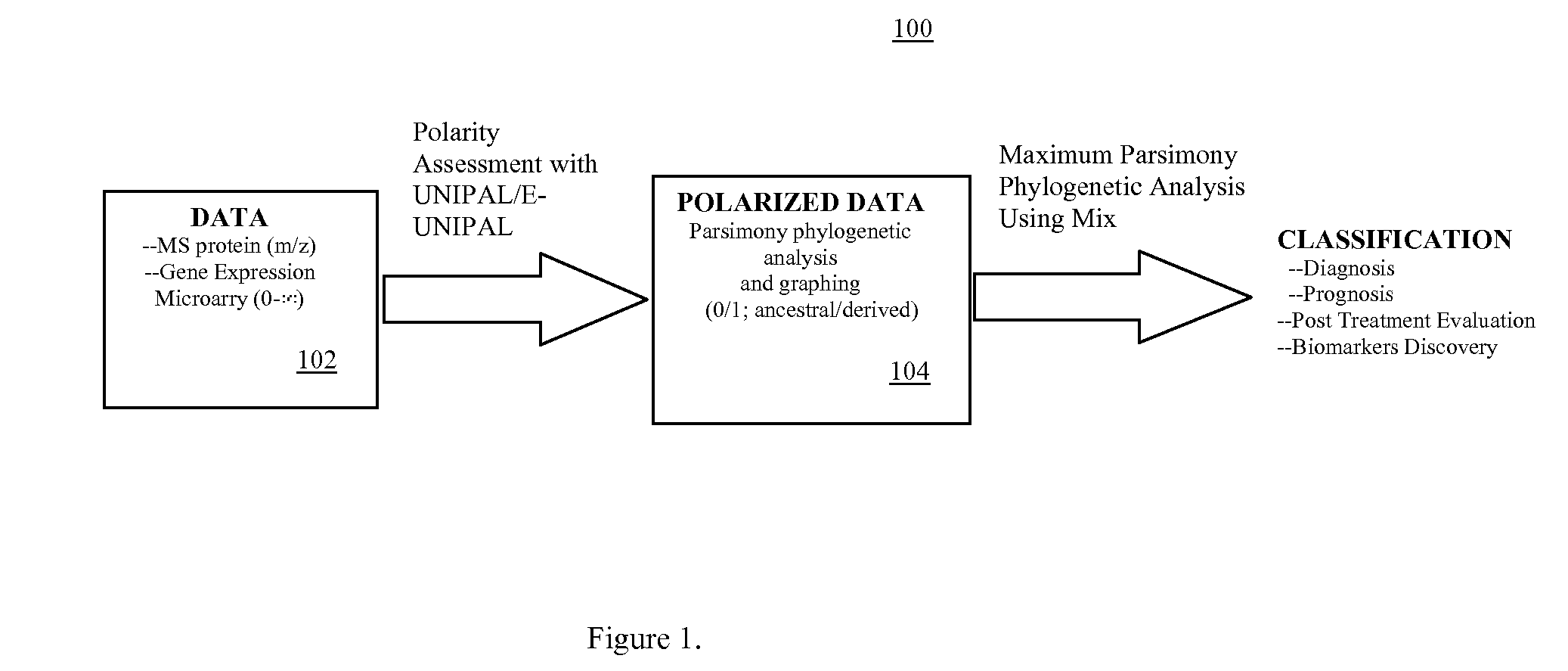Phylogenetic Analysis of Mass Spectrometry or Gene Array Data for the Diagnosis of Physiological Conditions
a mass spectrometry or gene array technology, applied in the field of universal data mining platform, can solve the problems of unattainable comparability of proteomic analyses performed in diverse locations, difficulty in classifying specimens on the basis of overall similarity,
- Summary
- Abstract
- Description
- Claims
- Application Information
AI Technical Summary
Benefits of technology
Problems solved by technology
Method used
Image
Examples
example 1
[0056] A mass spectrometry (MS) data of serum proteins was generated by surface-enhanced laser desorption-ionization time-of-flight (SELDI-TOF) of 460 specimens from three types of cancer: ovarian (n=143), pancreatic (n=70), and prostate (n=36), as well as from non-cancerous specimens (n=211). See FIG. 4. All sets of data used in samples were available from the NCI-FDA Clinical Proteomics Program, and are referred to in a few publications (http: / / home.ccr.cancer.gov / ncifdaproteomics / ppatterns.asp).
[0057] A.3. Results
[0058] A phylogenetic tree termed cladogram that shows the hierarchical classification in a graphical format best illustrates the results of a phylogenetic analysis. Parsimony analysis produced one most parsimonious cladogram (requiring the least amount of steps in constructing a classification of specimens) for each of the pancreatic and prostate specimens (FIGS. 2A& B), 5 equally parsimonious cladograms for ovarian specimens (FIG. 2C shows only one), and several equa...
example 2
[0128] We used all the expression data points of all specimens in the analysis, except those marked as null. For polarity assessment (apomorphic [or derived] vs. plesiomorphic [or ancestral]), data was polarized with a customized algorithm (E-UNIPAL) written by the Applicants that recognized derived values of each gene when compared with the outgroups. Outgroups here are preferably composed of normal specimens only (i.e., those that have been determined to be healthy and / or normal). E-UNIPAL determines the polarity for every data point among the specimens via outgroup comparison, and then scores each value of the study group as derived (1) or ancestral (0). Ideally, the outgroup should be large enough to encompass the maximum variation within normal specimens. In a less preferred, alternate embodiment, the score can be a weighted score (preferably between 1 and 0) that can vary between data points to emphasize or de-emphasize particular values.
[0129] The phylogenetic analysis of th...
example 3
[0161] Recent data made available to us has further confirmed the results of the efficacy of the invention. Microarray data on prostate cancer tissues, both primary and metastatic (GDS1439), were obtained from http: / / www.ncbi.nlm.nih.gov / geo / and processed according to the invention. FIG. 7 shows a cladogram graphing the results of the primary and metastatic cancer using Applicant's E-UNIPAL algorithm and MIX. Metastatic cancer, which is generally more difficult to treat as the dedifferentiation in the tissue becomes more pronounced, is readily clustered together by the phylogenetic classification. The upper portion of the graph contains the metastatic delineated from the lower portion of the graph containing primary cancer specimens. In particular, the upper part of the cladogram (specimens in red lettering: GSM74890, GSM74891, GSM74888, GSM74889, GSM74892, GSM74893) are the metastatic prostate specimens; the part below it (specimens in black lettering: GSM74882, GSM74886, GSM74887...
PUM
| Property | Measurement | Unit |
|---|---|---|
| Volume | aaaaa | aaaaa |
| Fraction | aaaaa | aaaaa |
| Fraction | aaaaa | aaaaa |
Abstract
Description
Claims
Application Information
 Login to View More
Login to View More - R&D
- Intellectual Property
- Life Sciences
- Materials
- Tech Scout
- Unparalleled Data Quality
- Higher Quality Content
- 60% Fewer Hallucinations
Browse by: Latest US Patents, China's latest patents, Technical Efficacy Thesaurus, Application Domain, Technology Topic, Popular Technical Reports.
© 2025 PatSnap. All rights reserved.Legal|Privacy policy|Modern Slavery Act Transparency Statement|Sitemap|About US| Contact US: help@patsnap.com



